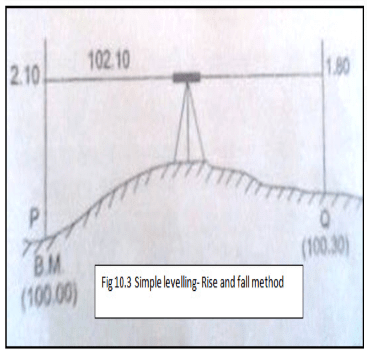Methods of Levelling - Simple Levelling and Fly Levelling methods, Surveying and Levelling | Surveying and Levelling Notes- Agricultural Engg - Agricultural Engineering PDF Download
RISE AND FALL METHOD
- The staff readings of the points observed from the same setting of the instrument are compared.
- It is found whether a point is above or below the preceding point.
- If the point is above, the staff reading will be less than the preceding point. The difference between the staff readings is called rise.
- If the point is below the preceding point, the staff reading will be greater than that at the preceding point. The difference between the staff readings is termed fall.

The difference between the staff readings at P and Q
= 2.10 – 1.80 = 0.30 (rise)
Hence, level of Q = Elevation of P + Rise
= 100.00+0.30 = 100.30 m
Back sight | Intermediate station | Fore sight | Rise | Fall | Reduced Level | Remarks |
1.245 | 100.00 | BM | ||||
2.100 | 0.855 | 99.145 | ||||
2.425 | 0.810 | 1.290 | 100.435 | STATION A | ||
0.480 | 1.945 | 102.380 | STATION B | |||
∑BS 3.670 | ∑FS 1.290 | ∑RISE 3.235 | ∑FALL 0.855 |
Arithmetical Check of Rise and Fall method
∑ B.S - ∑F.S = ∑Rise - ∑ Fall = Last R.L – First R.L.
3.670 – 1.290 = 3.235 – 0.855 = 102.380 – 100.00
2.380 = 2.380 = 2.380
Height of collimation or Height of instrument method: In this method, the height of the instrument is established for each setting of the instrument and the reduced level of the new point is arrived by detecting the fore sight reading of that point.
FAQs on Methods of Levelling - Simple Levelling and Fly Levelling methods, Surveying and Levelling - Surveying and Levelling Notes- Agricultural Engg - Agricultural Engineering
| 1. What is simple levelling? |  |
| 2. How does fly levelling differ from simple levelling? |  |
| 3. What is the role of surveying and levelling in agricultural engineering? |  |
| 4. What are the advantages of using the simple levelling method? |  |
| 5. Is fly levelling suitable for all types of surveying projects? |  |

|
Explore Courses for Agricultural Engineering exam
|

|
















